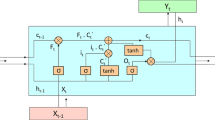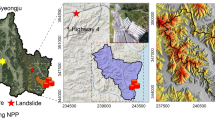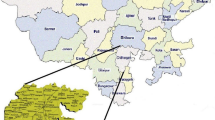Abstract
Rainfall stands out as a critical trigger for landslides, particularly given the intense summer rainfall experienced in Zheduotang, a transitional zone from the southwest edge of Sichuan Basin to Qinghai Tibet Plateau. This area is characterized by adverse geological conditions such as rock piles, debris slopes and unstable slopes. Furthermore, due to the absence of historical rainfall records and landslide inventories, empirical methods are not applicable for the analysis of rainfall-induced landslides. Thus we employ a physically based landslide susceptibility analysis model by using high-precision unmanned aerial vehicle (UAV) photogrammetry, field boreholes and long short term memory (LSTM) neural network to obtain regional topography, soil properties, and rainfall parameters. We applied the Transient Rainfall Infiltration and Grid-Based Regional Slope-Stability (TRIGRS) model to simulate the distribution of shallow landslides and variations in porewater pressure across the region under different rainfall intensities and three rainfall patterns (advanced, uniform, and delayed). The landslides caused by advanced rainfall pattern mostly occurred in the first 12 hours, but the landslides caused by delayed rainfall pattern mostly occurred in the last 12 hours. However, all the three rainfall patterns yielded landslide susceptibility zones categorized as high (1.16%), medium (8.06%), and low (90.78%). Furthermore, total precipitation with a rainfall intensity of 35 mm/h for 1 hour was less than that with a rainfall intensity of 1.775 mm/h for 24 hours, but the areas with high and medium susceptibility increased by 3.1%. This study combines UAV photogrammetry and LSTM neural networks to obtain more accurate input data for the TRIGRS model, offering an effective approach for predicting rainfall-induced shallow landslides in regions lacking historical rainfall records and landslide inventories.
Similar content being viewed by others
Availability of Data/Materials: The data that support the findings of this study are available from the corresponding author, upon reasonable request.
References
AbdelRahman MAE, Zakarya YM, Metwaly MM, et al. (2021) Deciphering Soil Spatial Variability through Geostatistics and Interpolation Techniques. Sustainability 13(1): 194. https://doi.org/10.3390/su13010194
Acharya TD, Tae YI, Lee D (2017) GIS-based Landslide Susceptibility Mapping of Bhotang, Nepal using Frequency Ratio and Statistical Index Methods. J Korean Soc Surv Geod Photogramm Cartogr 35(5): 357–364. https://doi.org/10.7848/ksgpc.2017.35.5.357
Basu T, Pal S (2020) A GIS-based factor clustering and landslide susceptibility analysis using AHP for Gish River Basin, India. Environ Dev Sustain 22(5): 4787–4819. https://doi.org/10.1007/s10668-019-00406-4
Baum RL, Savage WZ, Godt JW (2002) TRIGRS - A Fortran Program for transient Rainfall Infiltration and Grid-Based Regional Slope-Stability analysis. USGS, Colorado. https://doi.org/10.3133/ofr02424
Bel-Lahbib S, Namr KI, Rerhou B, et al. (2023) Assessment of soil quality by modeling soil quality index and mapping soil parameters using IDW interpolation in Moroccan semi-arid. Model Earth Syst Environ. https://doi.org/10.1007/s40808-023-01718-1
Bogaard T, Greco R (2018) Invited perspectives: Hydrological perspectives on precipitation intensity-duration thresholds for landslide initiation: proposing hydro-meteorological thresholds. Nat Hazards Earth Syst Sci 18(1): 31–39. https://doi.org/10.5194/nhess-18-31-2018
Bordoni M, Corradini B, Lucchelli L, et al. (2019) Empirical and Physically Based Thresholds for the Occurrence of Shallow Landslides in a Prone Area of Northern Italian Apennines. Water 11(12):2653. https://doi.org/10.3390/w11122653
Bordoni M, Galanti Y, Bartelletti C, et al. (2020) The influence of the inventory on the determination of the rainfall-induced shallow landslides susceptibility using generalized additive models. Catena 193: 104630. https://doi.org/10.1016/j.catena.2020.104630
Chen B, Li Z, Zhang C, et al. (2022) Wide Area Detection and Distribution Characteristics of Landslides along Sichuan Expressways. Remote Sens 14(14): 3431. https://doi.org/10.3390/rs14143431
Chen XL, Liu CG, Chang ZF, et al. (2016) The relationship between the slope angle and the landslide size derived from limit equilibrium simulations. Geomorphology 253: 547–550. https://doi.org/10.1016/j.geomorph.2015.01.036
Chen YC, Gao JJ, Bin ZH, et al. (2021) Application study of IFAS and LSTM models on runoff simulation and flood prediction in the Tokachi River basin. J Hydroinform 23(5): 1098–1111. https://doi.org/10.2166/hydro.2021.035
Chen Y, Chen D, Li Z, et al. (2016) Preliminary studies on the dynamic prediction method of rainfall-triggered landslide. J Mt Sci 13(10):1735–1745. https://doi.org/10.1007/s11629-014-3110-5
Ciurleo M, Ferlisi S, Foresta V, et al. (2022) Landslide Susceptibility Analysis by Applying TRIGRS to a Reliable Geotechnical Slope Model. Geosciences 12(1): 18. https://doi.org/10.3390/geosciences12010018
Ciurleo M, Mandaglio MC, Moraci N (2019) Landslide susceptibility assessment by TRIGRS in a frequently affected shallow instability area. Landslides 16(1): 175–188. https://doi.org/10.1007/s10346-018-1072-3
Coe JA, Michael JA, Crovelli RA, et al. (2004) Probabilistic assessment of precipitation-triggered landslides using historical records of landslide occurrence, Seattle, Washington. Environ Eng Geosci 10(2): 103–122. https://doi.org/10.2113/10.2.103
Dahal R (2017) Landslide hazard mapping in GIS. J Nepal Geol Soc 53: 63–91. https://doi.org/10.3126/jngs.v53i0.23808
do Pinho TM, Augusto Filho O (2022) Landslide susceptibility mapping using the infinite slope, SHALSTAB, SINMAP, and TRIGRS models in Serra do Mar, Brazil. J Mt Sci 19(4): 1018–1036. https://doi.org/10.1007/s11629-021-7057-z
Frame JM, Kratzert F, Klotz D, et al. (2022) Deep learning rainfall-runoff predictions of extreme events. Hydrol Earth Syst Sci 26(13): 3377–3392. https://doi.org/10.5194/hess-26-3377-2022
Francisco S, William LT, Allen MW (2008) Probability and Risk of Slope Failure. J Geotech Geoenviron Eng 134(12): 1691–1699. https://doi.org/10.1061/(asce)1090-0241(2008)134:12(1691)
Fusco F, De Vita P, Mirus BB, et al. (2019) Physically Based Estimation of Rainfall Thresholds Triggering Shallow Landslides in Volcanic Slopes of Southern Italy. Water 11(9): 1915. https://doi.org/10.3390/w11091915
Gao Y, Zhang Y, Ma C, et al. (2023) Failure process and stability analysis of landslides in Southwest China while considering rainfall and supporting conditions. Front Env Sci 10: 1084151. https://doi.org/10.3389/fenvs.2022.1084151
Gong Q, Wang J, Zhou P, et al. (2021) A Regional Landslide Stability Analysis Method under the Combined Impact of Rainfall and Vegetation Roots in South China. Adv Civ Eng 5512281. https://doi.org/10.1155/2021/5512281
Guo D, Hamada M (2013) Qualitative and quantitative analysis on landslide influential factors during Wenchuan earthquake: A case study in Wenchuan County. Eng Geol 152(1): 202–209. https://doi.org/10.1016/j.enggeo.2012.10.012
Ijaz Z, Zhao C, Ijaz N, et al. (2023) Statistical evaluation of multiple interpolation techniques for spatial mapping of highly variable geotechnical facets of soil in natural deposition. Earth Sci Inform. https://doi.org/10.1007/s12145-022-00924-2
Iverson RM (2000) Landslide triggering by rain infiltration. Water Resour Res 36: 1897–1910. https://doi.org/10.1029/2000WR900090
Jaiswal P, van Westen CJ, Jetten V (2011) Quantitative assessment of landslide hazard along transportation lines using historical records. Landslides 8(3): 279–291. https://doi.org/10.1007/s10346-011-0252-1
Kim H, Lee J-H, Park H-J, et al. (2021) Assessment of temporal probability for rainfall-induced landslides based on nonstationary extreme value analysis. Eng Geol 294: 106372. https://doi.org/10.1016/j.enggeo.2021.106372
Li CJ, Guo CX, Yang XG, et al. (2022) A GIS-based probabilistic analysis model for rainfall-induced shallow landslides in mountainous areas. Environ Earth Sci 81(17): 432. https://doi.org/10.1007/s12665-022-10562-y
Li Q (2018) Experimental study on the infiltration characteristics of airport gravel soil and numerical simulation of infiltration deformation of gravel high fill slopes. Master’s thesis, Nanjing University of Science and Technology, Nanjing. p 32. (In Chinese)
Liao Z, Hong Y, Kirschbaum D, et al. (2011) Evaluation of TRIGRS (transient rainfall infiltration and grid-based regional slope-stability analysis)’s predictive skill for hurricane-triggered landslides: a case study in Macon County, North Carolina. Nat Hazards 58(1): 325–339. https://doi.org/10.1007/s11069-010-9670-y
Listo FdLR, Gomes MCV, Ferreira FS (2021) Evaluation of shallow landslide susceptibility and Factor of Safety variation using the TRIGRS model, Serra do Mar Mountain Range, Brazil. J South Am Earth Sci 107: 103011. https://doi.org/10.1016/j.jsames.2020.103011
Liu S, Liu A (2006) Landslide hazard development characteristics and formation conditions in Kangding County, Sichuan Province. Chin J Geol Hazard Control 17(3): 27–31. (In Chinese)
Ma S, Shao X, Xu C (2022) Characterizing the Distribution Pattern and a Physically Based Susceptibility Assessment of Shallow Landslides Triggered by the 2019 Heavy Rainfall Event in Longchuan County, Guangdong Province, China. Remote Sens 14(17): 4257. https://doi.org/10.3390/rs14174257
Ma S, Shao X, Xu C, et al. (2021) MAT.TRIGRS (V1.0): A new open-source tool for predicting spatiotemporal distribution of rainfall-induced landslides. Nat Hazards Res 1(4): 161–170. https://doi.org/10.1016/j.nhres.2021.11.001
Marin RJ, Fernanda Velasquez M (2020) Influence of hydraulic properties on physically modelling slope stability and the definition of rainfall thresholds for shallow landslides. Geomorphology 351: 106976. https://doi.org/10.1016/j.geomorph.2019.106976
Marin RJ, Garcia EF, Aristizabal E (2021) Assessing the Effectiveness of TRIGRS for Predicting Unstable Areas in a Tropical Mountain Basin (Colombian Andes). Geotech Geol Eng 39(3): 2329–2346. https://doi.org/10.1007/s10706-020-01630-w
Medina V, Hurlimann M, Guo Z, et al. (2021) Fast physically-based model for rainfall-induced landslide susceptibility assessment at regional scale. Catena 201: 105213. https://doi.org/10.1016/j.catena.2021.105213
Montgomery DR, Dietrich WE (1994) A physically based model for the topographic control on shallow landsliding. Water Resour Res 30: 1153–1171. https://doi.org/10.1029/93WR02979
Nandi A, Shakoor A (2010) A GIS-based landslide susceptibility evaluation using bivariate and multivariate statistical analyses. Eng Geol 110(1–2): 11–20. https://doi.org/10.1016/j.enggeo.2009.10.001
Nie Y, Li X, Xu R (2022) Dynamic hazard assessment of debris flow based on TRIGRS and flow-R coupled models. Stoch Environ Res Risk Assess 36(1): 97–114. https://doi.org/10.1007/s00477-021-02093-y
Park DW, Nikhil NV, Lee SR (2013) Landslide and debris flow susceptibility zonation using TRIGRS for the 2011 Seoul landslide event. Nat Hazards Earth Syst Sci 13(11): 2833–2849. https://doi.org/10.5194/nhess-13-2833-2013
Piacentini D, Troiani F, Daniele G, et al. (2018) Historical geospatial database for landslide analysis: the Catalogue of Landslide OCcurrences in the Emilia-Romagna Region (CLOCkER). Landslides 15(4): 811–822. https://doi.org/10.1007/s10346-018-0962-8
Raheem AM, Omar NQ, Naser IJ, et al. (2022) GIS implementation and statistical analysis for significant characteristics of Kirkuk soil. J Mech Behav Mater 31(1): 691–700. https://doi.org/10.1515/jmbm-2022-0073
Rana H, Babu GLS (2022) Regional back analysis of landslide events using TRIGRS model and rainfall threshold: an approach to estimate landslide hazard for Kodagu, India. Bull Eng Geol Environ 81(4):160. https://doi.org/10.1007/s10064-022-02660-9
Salciarini D, Godt JW, Savage WZ, et al. (2006) Modeling regional initiation of rainfall-induced shallow landslides in the eastern Umbria Region of central Italy. Landslides 3(3): 181–194. https://doi.org/10.1007/s10346-006-0037-0
Sepp H, Jürgen S (1997) Long Short-term Memory. Neural Comput 9(8): 1735–1780. https://doi.org/10.1162/neco.1997.9.8.1735
Shahabi H, Hashim M, Ahmad BB (2015) Remote sensing and GIS-based landslide susceptibility mapping using frequency ratio, logistic regression, and fuzzy logic methods at the central Zab basin, Iran. Environ Earth Sci 73(12): 8647–8668. https://doi.org/10.1007/s12665-015-4028-0
Song X, Tan Y (2021) Experimental investigation on the influences of rainfall patterns on instability of sandy slopes. Environ Earth Sci 80(24): 803. https://doi.org/10.1007/s12665-021-10118-6
Srivastava R, Yeh TCJ (1991) Analytical solutions for one-dimensional, transient infiltration toward the water table in homogeneous and layered soils. Water Resour Res 27: 753–762. https://doi.org/10.1029/90WR02772
Taylor DW (1948) Fundamentals of Soil Mechanics. Soil Sci 66(2): 161. https://doi.org/10.1097/00010694-194808000-00008
Terzaghi K (1943) Theoretical Soil Mechanics. John Wiley and Sons. New York.
Thomas MA, Mirus BB, Collins BD (2018) Identifying Physics-Based Thresholds for Rainfall-Induced Landsliding. Geophys Res Lett 45(18): 9651–9661. https://doi.org/10.1029/2018gl079662
Tran TV, Massimiliano A, Giha L, et al. (2018) Three-dimensional, time-dependent modeling of rainfall-induced landslides over a digital landscape: a case study. Landslides 15(6): 1071–1084. https://doi.org/10.1007/s10346-017-0931-7
Weidner L, Oommen T, Escobar-Wolf R, et al. (2018) Regional-scale back-analysis using TRIGRS: an approach to advance landslide hazard modeling and prediction in sparse data regions. Landslides 15(12): 2343–2356. https://doi.org/10.1007/s10346-018-1044-7
Wu J, Wang Y, Dong S, et al. (2013) Genetic mechanism and failure process of the Mogangling seismic landslide. J Geol Soc India 82(3): 277–282. https://doi.org/10.1007/s12594-013-0150-3
Wu K (2015) The genetic mechanism and control of debris flow in Sichuan Kangding Muwa gutter. Shanxi Archit 41(20): 7–9. (In Chinese)
Yin H, Zhang X, Wang F, et al. (2021) Rainfall-runoff modeling using LSTM-based multi-state-vector sequence-to-sequence model. J Hydrol 598: 126378. https://doi.org/10.1016/j.jhydrol.2021.126378
Zeng T (2018) Analysis of particle characteristics and physical and mechanical properties of ice water accumulation in high cold regions. Master’s thesis, Southwest Jiaotong University, Chengdu. p 29. (In Chinese)
Zhang F, Wang J, LI C, et al. (2021) Analysis of deformation and failure characteristics and formation mechanism of Zheduotang landslide. J Geol Hazards Environ Preserv 32(2): 3–7. (In Chinese)
Zhang K, Xue X, Hong Y, et al. (2016) iCRESTRIGRS: a coupled modeling system for cascading flood-landslide disaster forecasting. Hydrol Earth Syst Sci 20(12): 5035–5048. https://doi.org/10.5194/hess-20-5035-2016
Zhang S, Jiang Q, Wu D, et al. (2022a) Improved Method of Defining Rainfall Intensity and Duration Thresholds for Shallow Landslides Based on TRIGRS. Water 14(4): 524. https://doi.org/10.3390/w14040524
Zhang S, Jiang Q, Xu X, et al. (2022b) Influence of soil mechanical and hydraulic parameters on the definition of rainfall intensity and duration thresholds based on Transient rainfall infiltration and grid-based regional slope-stability model (TRIGRS). Front Earth Sci 10: 1014983. https://doi.org/10.3389/feart.2022.971655
Zhang S, Zhao L, Delgado-Tellez R, et al. (2018) A physics-based probabilistic forecasting model for rainfall-induced shallow landslides at regional scale. Nat Hazards Earth Syst Sci 18(3): 969–982. https://doi.org/10.5194/nhess-18-969-2018
Zhang W, Xiao D (2019) Numerical analysis of the effect of strength parameters on the large-deformation flow process of earthquake-induced landslides. Eng Geol 260: 105239. https://doi.org/10.1016/j.enggeo.2019.105239
Zhou W, Qiu H, Wang L, et al. (2022) Combining rainfall-induced shallow landslides and subsequent debris flows for hazard chain prediction. Catena 213: 106199. https://doi.org/10.1016/j.catena.2022.106199
Zhuang J, Peng J, Wang G, et al. (2017) Prediction of rainfall-induced shallow landslides in the Loess Plateau, Yan’an, China, using the TRIGRS model. Earth Surf Processes Landforms 42(6): 915–927. https://doi.org/10.1002/esp.4050
Acknowledgments
This study was financially supported by many institutions, including the National Natural Science Foundation of China (No. 51878668), the Natural Science Foundation of Hunan Province (No. 2021JJ10063), the Fundamental Research Funds for the Central Universities of Central South University (Nos. 2020zzts167, 2020zzts154, 2019zzts009). All financial supports were greatly appreciated.
Author information
Authors and Affiliations
Contributions
ZHAO Lian-heng: Funding acquisition, Project administration, Writing–original draft. XU Xin: Investigation, Methodology, Software, Writing–review & editing. LYU Guo-shun: Project administration, Supervision, Writing–review & editing. HUANG Dongliang: Methodology, Data curation, Resources. LIU Min: Conceptualization, Writing–review & editing, Investigation. CHEN Qi-min: Data curation, Resources.
Corresponding author
Ethics declarations
Conflict of Interest: The authors declare no conflict of interest.
Rights and permissions
About this article
Cite this article
Zhao, Lh., Xu, X., Lyu, Gs. et al. Sensitivity analysis of regional rainfall-induced landslide based on UAV photogrammetry and LSTM neural network. J. Mt. Sci. 20, 3312–3326 (2023). https://doi.org/10.1007/s11629-023-7991-z
Received:
Revised:
Accepted:
Published:
Issue Date:
DOI: https://doi.org/10.1007/s11629-023-7991-z




